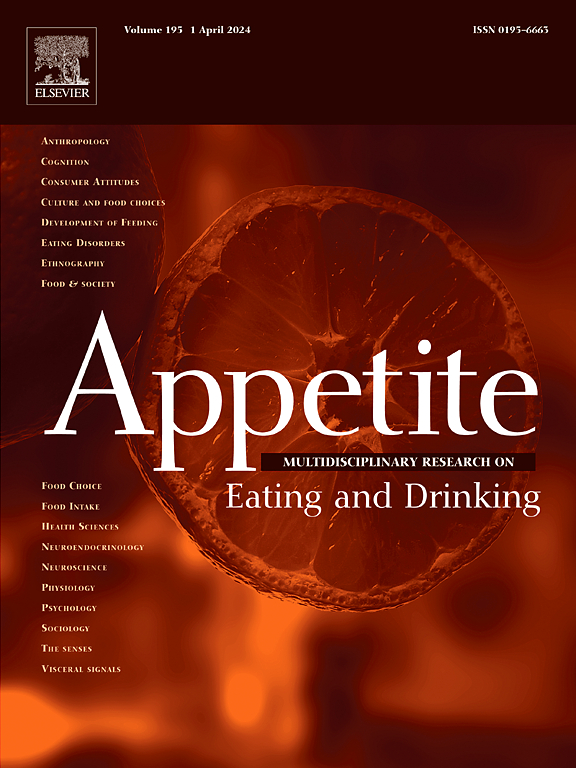对非运动员对运动食品的风险、法规和包装的定性探索归因于他们对运动食品的看法。
IF 4.6
2区 医学
Q1 BEHAVIORAL SCIENCES
引用次数: 0
摘要
尽管运动食品的目的是为运动员补充额外的营养摄入,但在澳大利亚,非运动员越来越多地消费运动食品。有证据表明,这些食品被视为常规食品,被非运动员用于违背其设计目的的用途,构成健康风险。消费者还依赖数字媒体来源来推荐产品,并使用误导性的包装信息来选择产品,尽管其原因尚不清楚。本研究旨在探讨澳大利亚非运动员消费者对风险、法规和改进建议的看法,以及警告和包装属性如何指导非运动员运动食品的选择。对15名非运动员澳大利亚成人运动食品消费者进行了定性半结构化访谈。使用NVivo软件对反应进行反身性主题分析。参与者对与运动食品消费相关的风险有不同的看法,认为它们对他人的风险很高,但对自己的风险有限。消费者更信任营养信息小组和声明,而不是其他属性,这些被认为更可信。数字媒体是运动食品选择的主要推荐来源。与会者提到,警告是一般性的,认为这些警告不适用于他们,政府法规缺乏可信度。与会者还建议改进警告标签和监管措施。非运动员对运动食品的消费受到以下因素的影响:对个人风险的态度、数字媒体的说服性影响以及对警告和规定不充分的看法。研究结果强调需要更严格的包装和法规,以确保营销控制,并提供更安全的运动食品,以减轻非运动员在选择这些产品时面临的一些风险。本文章由计算机程序翻译,如有差异,请以英文原文为准。
“It's not like they're selling drugs over the counter” A qualitative exploration of risks, regulations and packaging attribute perceptions of sports foods in non-athletes
Sports foods are increasingly being consumed by non-athletes in Australia, despite their intended purpose to supplement additional nutrient intake for athletes. Evidence suggests that these are perceived as regular foods and are being used by non-athletes for purposes contrary to which they were designed, posing health risks. Consumers are also relying on digital media sources for the recommendation of products and using misleading packaging information to select products, although their reasons are unclear. This study aimed to explore non-athlete consumers’ perceptions of the risks, regulations and suggestions for improvement and, how warnings and packaging attributes guide non-athlete sports food choices in Australia. Qualitative semi-structured interviews with 15 non-athlete Australian adult sports food consumers were conducted. Reflexive thematic analysis was used to code responses using NVivo software. Participants had conflicting views on the risks associated with sports food consumption perceiving them to be high risk to others but of limited risk to themselves. Consumers trusted the Nutrition Information Panel and claims more than other attributes, and these were seen as more credible. Digital media was the key source of recommendation for sports food selection. Participants mentioned that warnings were generic, believed they were not applicable to them and that government regulations lacked credibility. Participants also suggested improvements for warning labels and regulatory measures. Consumption of sports foods by non-athletes is influenced by attitudes towards personal risks, the persuasive influence of digital media, and perceptions of the warnings and regulations as inadequate. Findings highlight the need for stricter packaging and regulations that ensure marketing controls and provide safer sports food products to mitigate some of the risks that non-athletes face when selecting these products.
求助全文
通过发布文献求助,成功后即可免费获取论文全文。
去求助
来源期刊

Appetite
医学-行为科学
CiteScore
9.10
自引率
11.10%
发文量
566
审稿时长
13.4 weeks
期刊介绍:
Appetite is an international research journal specializing in cultural, social, psychological, sensory and physiological influences on the selection and intake of foods and drinks. It covers normal and disordered eating and drinking and welcomes studies of both human and non-human animal behaviour toward food. Appetite publishes research reports, reviews and commentaries. Thematic special issues appear regularly. From time to time the journal carries abstracts from professional meetings. Submissions to Appetite are expected to be based primarily on observations directly related to the selection and intake of foods and drinks; papers that are primarily focused on topics such as nutrition or obesity will not be considered unless they specifically make a novel scientific contribution to the understanding of appetite in line with the journal's aims and scope.
 求助内容:
求助内容: 应助结果提醒方式:
应助结果提醒方式:


